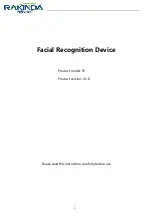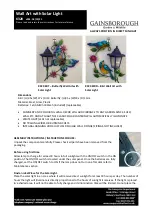
G
Mounting and Installation
Rev. 2020 - V35
ATTENTION!
There is no universally uniform standard, which could be applied to a
VOC sensor
(Volatile Organic Compounds). The monitored air contains a large
number of substances to which the sensor responds, and gas mixtures are adjusted. Therefore this sensor does not act selectively, but rather
reflects the overall air quality. In principle, one also cannot state precisely what is "bad air" or what is "good air" because this is a purely subjective
sensation.
The gas inter-exchange in the sensor element happens by diffusion. Depending on the changes to the concentration and the flow velocity of the air
surrounding the sensor, the reaction of the device to the change of concentration may take place with a delay. It is essential to choose an installation
location for the device in which the air stream flows around the sensor. Otherwise the gas exchange may be considerably delayed or prevented.
Automatic calibration of air quality (default)
The automatic background logic is a self-calibrating mechanism that is suitable for use in applications in which the air quality regularly drops to
fresh air level. This should typically occur during times in which the rooms are unoccupied.
The sensor reaches its normal accuracy after 24 hours of continuous operation in an environment that has been subjected to a fresh air supply.
The deviation errors remain minimal if the sensor is exposed to fresh air at least 4 times within 28 days.
The device needs continuous operating cycles of more than 24 hours to operate correctly.
Manual calibration of air quality
After connecting the device, ensure continuous operation for at least 2 hours using air defined as "normal" air quality.
Manual calibration can be started by pressing the button position, irrespective of the DIP 3 -switch.
The calibration procedure is started by pressing the "ZERO" button (for approx. five seconds).
This is signalled via the flashing LED.
Then calibration takes place. During this phase, the LED is continuously active and a 600 second countdown runs.
Putting in operation
After switching on the device, a self-test and tempering period follows.
This process takes around 30 - 50 minutes, depending on the ambient conditions.
It is imperative to perform manual calibration once this process is completed.
Switching point setting
A switching point between 10 % and 95 % of the measuring range can be selected using the SET potentiometer.
A potential-free changeover contact is available as a switch output.
Offset
The VOC measured value can be adjusted subsequently using the offset potentiometer.
The adjusting range is ± 10 % of the measuring range.
Traffic light indicator
RLQ - W - A
VOC content
LED 1
green
LED 2
green
LED 3
yellow
LED 4
yellow
LED 5
red
0 %
25 %
–
–
–
–
5 %
50 %
–
–
–
–
10 %
75 %
–
–
–
–
15
%
100 %
–
–
–
–
20 %
25 %
–
–
–
25 %
50 %
–
–
–
30 %
75 %
–
–
–
35
%
100 %
–
–
–
40 %
25 %
–
–
45 %
50 %
–
–
50 %
75 %
–
–
55
%
100 %
–
–
60 %
25 %
–
65 %
50 %
–
70 %
75 %
–
75
%
100 %
–
80 %
25 %
85 %
50 %
90 %
75 %
95
%
100 %
100 %
Once the aforementioned values have been reached, the respective LED
becomes active (with increasing luminosity of 25 %, 50 %, 75 % and 100 %);
LEDs that are already active continue to be illuminated.
DIP switches
RLQ - W
VOC sensitivity
DIP 1
DIP 2
LOW
OFF
OFF
MEDIUM (default)
O N
OFF
HIGH
OFF
O N
VOC automatic zero point
DIP 3
deactivated
OFF
activated (default)
O N
Output
DIP 4
Voltage 0 -10 V (default)
OFF
Current 4...20 mA
O N
Traffic light (5x LEDs)
DIP 5
deactivated
OFF
activated
O N
DIP switches
RLQ - SD
VOC sensitivity
DIP 1
DIP 2
LOW
OFF
OFF
MEDIUM (default)
O N
OFF
HIGH
OFF
O N
Summary of Contents for AERASGARD RLQ-SD
Page 7: ......
Page 12: ...AERASGARD RLQ W AERASGARD RLQ SD G Kryt Baldur Housing ...






























